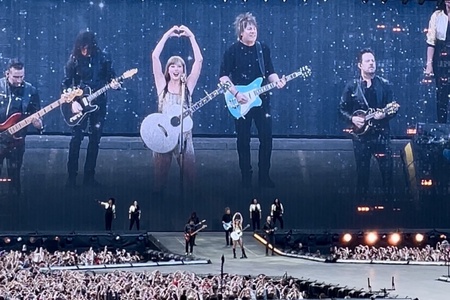The British Geological Survey (BGS) has officially declared Taylor Swift’s Eras Tour ‘ground-shaking’ after seismic monitoring stations in the region recorded seismic activity each night Swift was performing in Edinburgh earlier this month. Friday night’s crowd in particular made the whole place shimmer, setting the record for the Eras Tour’s Scotland dates with a maximum of 23.4 nanometres (nm) of movement.
Dr David Cornwell, Senior Lecturer in Geophysics, explained “seismometers are very sensitive ground motion instruments that record all kinds of natural Earth vibrations, including earthquakes, wind, weather, waves, etc., and human-related vibrations such as cars, planes, construction, and of course ‘Swiftquakes’!
“Depending on how close a seismometer is to an earthquake – or Swiftquake – and how much shaking they generated, it should record a signal that can be analysed by seismologists to reveal amplitude, frequency, and location information of the events.”
Swift has a reputation for making sure her fans have the best day when attending her concerts. One of her Eras Tour concerts in Seattle generated seismic activity similar to that of a magnitude 2.3 earthquake – doubling the invisible vibrations previously felt at the stadium with the famous 2011 “Beast Quake,” according to an article in The Guardian.
Callum Harrison, a BGS seismologist, noted that “Scotland’s reputation for providing some of the most enthusiastic audience remains well intact!” Indeed, those who have previously attended events at Murrayfield know all too well that concertgoers’ enthusiasm at the stadium never goes out of style. The Guardian noted that Harry Styles’ Love On Tour performances in Edinburgh last May prompted a reading of 30.9nm – the highest reading since BGS’s records for Murrayfield concerts began.
So how did it end? Long story short, while Swifties may be disappointed Miss Americana’s Eras Tour wasn’t the 1 to break the stadium record for seismic activity, it was clear those attending were wonderstruck by Swift’s performance nonetheless. Seismic activity recorded by the BGS monitoring stations during all three concerts followed a similar pattern, with “…Ready For It?” “Cruel Summer” and the applause following “champagne problems” generating the most activity each night.
How did the seismic activity generated by this summer’s Swiftquakes and past concerts and events compare to activity typically observed in Scotland? Dr Cornwell noted that “Scotland has a BGS network of 18 seismometers that constantly monitor earthquake activity and there are currently 30 “citizen seismometers” in people’s homes, museums, and schools. Scotland experiences hundreds of earthquakes every year – mainly in the west – but they are usually very small with minor shaking and only a handful are felt or cause any damage.”
“The largest Scottish earthquake was a magnitude 5.2 near Loch Awe in 1880 and the last one was a tiny magnitude 1.3 in northern Arran earlier this month, on 18th June 2024. Scottish earthquakes are either caused by tectonic forces related to the North Atlantic ocean opening or slow rebound of the land following the melting of ice that covered Scotland until around 10,000 years ago.”


